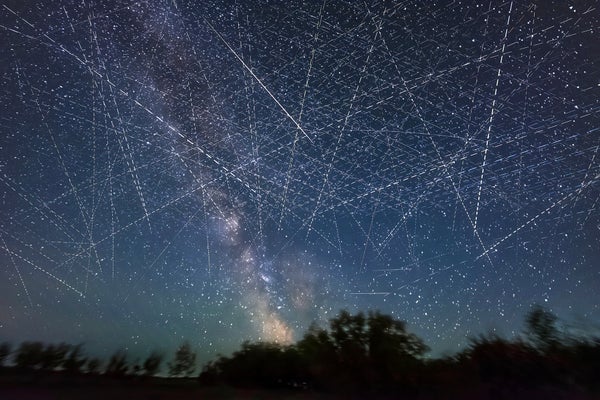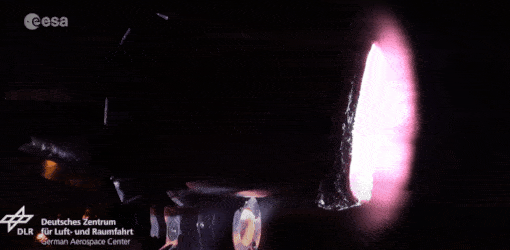Satellite megaconstellations could jeopardize recovery from ozone hole
Pollution from the growing number of satellites burning up in Earth’s atmosphere could threaten our planet’s protective ozone layer.

Light trails from low-Earth orbit satellites fill the sky in this long-exposure composite photograph, taken over a 30-minute period.
Alan Dyer/VWPics/Alamy Stock Photo
From the ground, Earth’s sky seems limitless and eternal, but the view from above shows something different: a dangerously thin blue line across the black void, all that stands between our living world and mortal conditions from space. It is in this fragile expanse that scientists now recognize a danger that has been present for a long time: pollution caused by the re-entry of satellites and other orbital debris. This emerging threat could compromise the delicate balance of our planet’s protective ozone layer, according to a new study.
Without a regular and costly restart, all satellites in low Earth orbit are doomed to a fiery fate: gradually losing altitude until they burn up and disintegrate against the thin outer layers of the atmosphere. Since the dawn of the space age, this process has been considered a simple, consequence-free way to remove Earth’s orbital waste. However, a new study inspired by the growing number of satellite reentries estimates that aluminum oxide air pollution from satellites increased eightfold between 2016 and 2022. Even more alarming, the research suggests that this accumulation of Debris can damage our protective layer of atmospheric ozone. “We shouldn’t jump to conclusions,” says José Ferreira, lead author of the study and a researcher at the University of Southern California, “but the numbers are very concerning.” The study appears in a June edition of Geophysical research letters.
Earth’s Broken Shield
On supporting science journalism
If you enjoy this article, please consider supporting our award-winning journalism by subscription. By purchasing a subscription, you are helping to ensure the future of impactful stories about the discoveries and ideas shaping our world today.
Ozone, a highly reactive compound made up of three oxygen atoms, is one of the most critical components of Earth’s atmosphere. Tight bonds hold the molecule’s oxygen atoms together, allowing an ozone layer in the stratosphere to absorb most of the harmful ultraviolet (UV) radiation from space, preventing it from reaching Earth’s surface. However, ozone is also likely to be degraded by human activities. In the 1970s, scientists discovered that chlorofluorocarbons (CFCs) in household products created a “hole” in the ozone layer, profoundly weakening its protective effects.
Although ongoing efforts to repair the ozone hole have yielded remarkable results, a new set of pollutants could reverse this trend. In a study published last October, scientists found unusually high amounts of vaporized metals such as aluminum, copper and lithium accumulating in the stratosphere – an anomaly attributed to rocket launches and satellite reentry . “We know that satellites re-enter the atmosphere, heat up, vaporize – (and) one way or another, these metals enter the stratosphere,” explains Martin Ross, author of this study and specialist in atmosphere and senior project engineer for Aerospace Corporation. He adds that a more complete understanding of the potential extent of pollution – from vaporization to sedimentation in the stratosphere – is needed.

A time-lapse view of a large satellite component melting and disintegrating during testing in a plasma wind tunnel.
The increase in the number of satellites appears to only exacerbate stratospheric metal levels. More than 8,000 of them already reside in low-Earth orbit, and tens of thousands more are planned, mostly in the form of so-called megaconstellations, like SpaceX’s Starlink, a satellite system that provides Internet access global broadband. Starlink and other megaconstellations rely on an economy of scale; their massive fleet is continually replenished with new satellites to replace the old ones burning up in Earth’s atmosphere. The result is a drastic increase in rocket launches and spacecraft reentries. “There is a widely held assumption that something that burns in the atmosphere disappears, but, of course, the mass never disappears,” says Michael Byers, Canada Research Chair in Global Politics and International Law and co-director of the Outer Space Institute.
Inspired by the striking detection of metals in the stratosphere last year, Ferreira and his colleagues examined the extent to which each satellite can deliver metal pollutants. Their study simulated interactions between an incoming satellite and oxygen atoms in the mesosphere, or middle layer of the atmosphere, located above the stratosphere. The work revealed that flash-heated aluminum from the diving satellite would quickly erode to react with oxygen and form aluminum oxide. It turns out that this could be very bad news for stratospheric ozone.
In sufficient concentrations, aluminum oxide readily catalyzes the destructive reaction of ozone with chlorine gas, which splits the ozone molecule and diminishes Earth’s UV shield. Additionally, because the aluminum oxide remains intact during this process, it can continue to react with ozone. The persistence of the compound means that even small amounts can potentially have significant long-term effects on the ozone layer. Adapting their results to current megaconstellations and publicly known future expansion plans, Ferreira and his co-authors estimate that in 2022 alone, satellites will have pumped 17 tons of aluminum oxide into Earth’s mesosphere. Frighteningly, this influx would amount to some 360 tonnes of aluminum oxide per year if the rapid and planned proliferation of megaconstellations continued. The study also modeled the atmospheric dynamics of aluminum oxide, showing that the particles could take up to 30 years to drift into the stratosphere and wreak havoc on the ozone layer. “As (the pollutant) builds up in the atmosphere, that’s time we’re wasting. By the time we see the results, it may be too late,” says Ferreira.
Defensive measures
Understanding how space debris attacks the ozone layer is only part of the battle. If independent studies validate these findings, the next critical challenge will be developing tactics to counteract these effects.
The discovery of the ozone hole in the 1970s led to the signing of the Montreal Protocol in the following decade, an international treaty that inspired world leaders to successfully combat the CFC problem in the 1980s. But applied to pollution from reentry satellites rather than from refrigerators and hairspray cans, this type of international treaty looks less like a model for solutions than a damning indictment of the shortcomings of our current regulatory frameworks. The Montreal Protocol has shown that with global coordination, complex environmental problems can be managed. Existing rules and restrictions regarding orbital activity, however, appear to offer poor and contradictory prospects for an easy solution. For example, the Federal Communications Commission requires that U.S. satellites in low Earth orbit be decommissioned within five years of the end of their mission. These regulations are primarily intended to prevent orbital overcrowding, but they do not take into account potential atmospheric impacts. “It’s an interesting paradox,” Ferreira says. “We need to clean up the orbital environment, but we don’t know what the cost to the atmosphere will be.”
Brian Weeden, systems director at Aerospace Corporation’s Center for Space Policy and Strategy, adds: “The current regulatory framework was not designed for this sort of thing. There’s no checkbox that says, “Also check whether or not this has an impact on the upper atmosphere,” because that wasn’t a question that anyone thought about. Still, satellite launches continue, and as we learn more about the process, “it’s becoming a bigger and bigger problem,” Ross says. “We are blind, but we continue to drive on the road. »
Ferreira and colleagues’ work reveals the increase in invisible space pollutants that threaten our protective atmosphere. But predicting atmospheric dynamics is a problem, and predicting the global response is potentially an even bigger problem. “I hope that this time we can be faster and smarter than when we look at climate change, for example,” adds Leonard Schulz, researcher at the Institute of Geophysics and Extraterrestrial Physics at the Technical University from Braunschweig in Germany. “We can move quickly on (this issue) and we need to work together.”